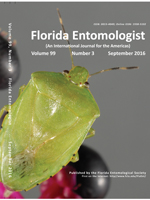Due to its role in the transmission of Candidatus Liberibacter asiaticus, a pathogen associated with huanglongbing, a catastrophic disease of citrus in the world, Diaphorina citri Kuwayama (Hemiptera: Liviidae) has become a very dangerous invasive pest. To contribute to increasing alternatives for its management, we evaluated against D. citri adults the pathogenicity of conidia and blastospores of 8 Mexican strains of the entomopathogenic fungus Hirsutella citriformis Speare (Hypocreales: Ophiocordycipitaceae). Furthermore, we conducted tests with non-target insects that included the predators Hippodamia convergens Guérin-Méneville (Coleoptera: Coccinellidae) and Chrysoperla rufilabris (Burmeister) (Neuroptera: Chrysopidae). Experiments in the laboratory included the application of the fungus by contact and through liquid sprays. Strains were collected from citrus areas of Mexico. They were grown in PDAY media and applied at 1 × 106 conidia per mL. All bioassays were conducted under controlled conditions at 26 ± 1 °C, a 16:8 h L:D photoperiod, and 76 ± 4% RH and maintained during 26 d after inoculation. Tests with D. citri were performed 3 times at different dates. Mean mortality by H. citriformis strains on D. citri adults ranged from 82 to 92%; INIFAP-Hir-1 strain produced the highest rate. Sprayed conidia produced 69% mortality. Use of sprayed blastospores caused 32 to 49 % mortality. LC50 obtained for INIFAP-Hir-1 strain was 3.4 × 106 conidia per mL. IB-Hir-1, IB-Hir-2, INIFAP-Hir-1, and INIFAP-Hir-2 strains inoculated by contact on H. convergens adults caused 9 to 11% mortality; in larvae of C. rufilabris, mortality ranged from 19 to 25%. In both tests, there were no statistical differences when compared with the untreated control. Unlike D. citri, all dead predator specimens showed absence of H. citriformis mycosis. The results suggest potential for the integration of this fungus in the management of D. citri. Data obtained from the predators could support safe use of this biological control agent.
How to translate text using browser tools
1 September 2016
Effect of Mexican Hirsutella citriformis (Hypocreales: Ophiocordycipitaceae) Strains on Diaphorina citri (Hemiptera: Liviidae) and the Predators Chrysoperla rufilabris (Neuroptera: Chrysopidae) and Hippodamia convergens (Coleoptera: Coccinellidae)
Orquídea Pérez-González,
Raúl Rodríguez-Guerra,
J. Isabel López-Arroyo,
Carlos Francisco Sandoval-Coronado,
María Guadalupe Maldonado-Blanco

Florida Entomologist
Vol. 99 • No. 3
September 2016
Vol. 99 • No. 3
September 2016
Asian citrus psyllid
biological control
Control biológico
Huanglongbing
insectos no blanco
non-target insect
psílido asiático de los cítricos




